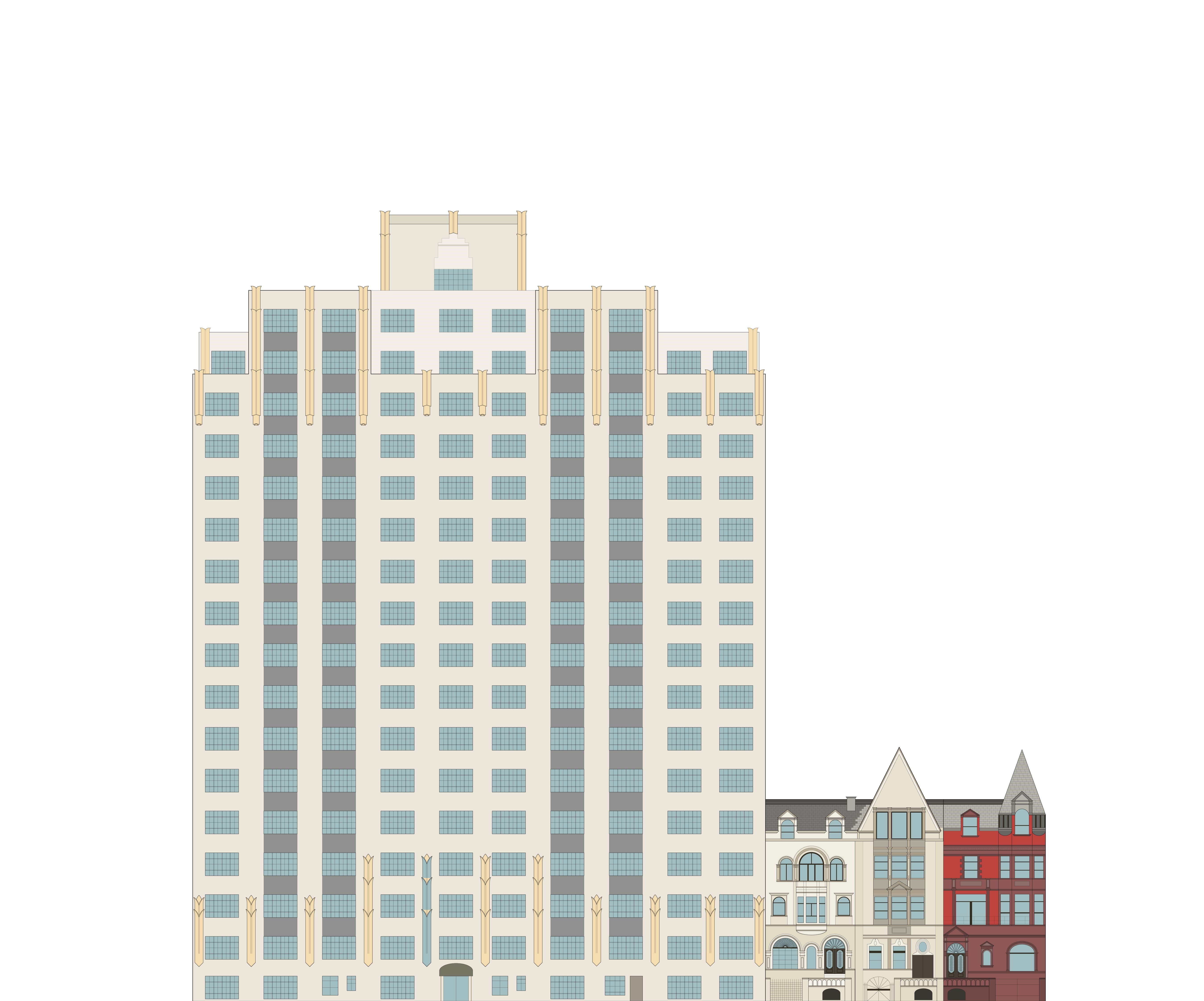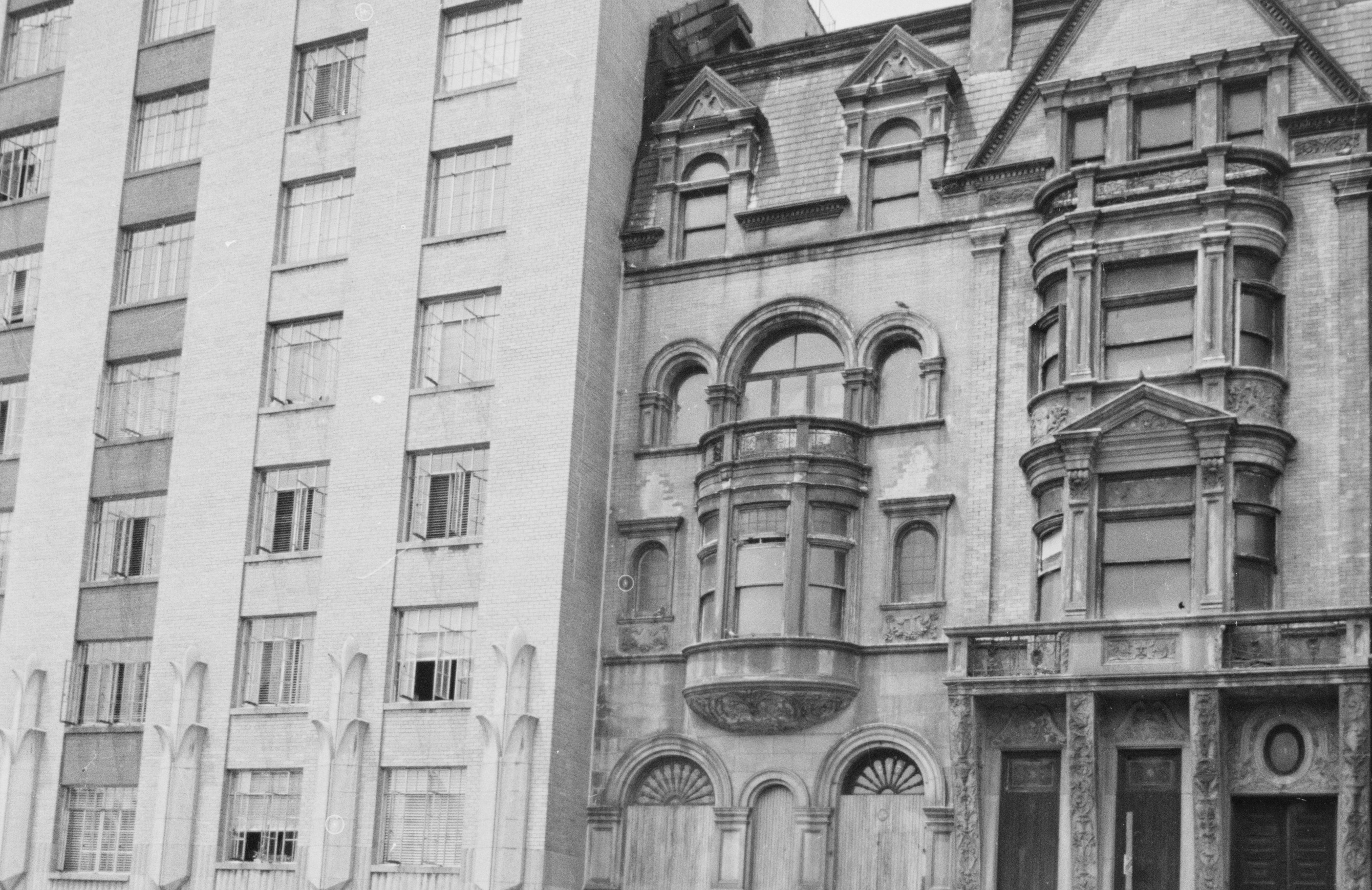
247 Central Park West
by Tom Miller
In 1887 architect, Edward Angell designed a row of nine upscale homes along Central Park from 84th to 85th Street for developer William Noble. Ground was broken in 1888 and construction was completed the following year. Nobel had spared no expense. Each cost him $37,000 to construct, or just over $1 million by 2023 terms.
While several of the Queen Anne style homes featured romantic gables and turrets, 247 Central Park West was noticeably formal. Its basement and parlor levels were clad in stone, the second and third in beige brick, while the fourth floor took the form of a dormer-punctured slate mansard. Angell designed the house to be perfectly symmetrical. Above the dogleg box stoop, the arched entrance was balanced by a parlor window with an exquisite stained glass fanlight. Between them was a smaller arched opening. A rounded oriel at the second floor provided a balcony to the third, where the arched windows were arranged in a Palladio inspired configuration.
Builder developer Samuel McMillan paid $60,000 for the 22-foot-wide house in July 1890. The owner of the construction firm Samuel McMillan & Co., he focused on the upgrading of the Hell’s Kitchen neighborhood, buying ramshackle structures and replacing them with modern flats.
Born in County Down, Ireland, McMillan was also a director in the Mutual Bank and the West Side Bank. The New York Times reported, “Mr. Samuel McMillen expended about $10,000 in the interior decorations, which include such unusual features as tufted silk wall coverings. The building is one of a row known as the Noble Houses, from the name of the builder.”
His residency at 247 Central Park West would be cut tragically short. On October 11, 1891, his wife, Elizabeth S. Short, died here after a brief illness. Her funeral was held in the drawing room three days later. The following September McMillan advertised the house for sale, describing it as “splendidly constructed and interior decorations unsurpassed.”
Instead, McMillan leased it briefly to the James W. Quintard family. A member of the Quintard Iron Works and a director in the Pacific Steamship Company, he and his wife Hedwig had four children, Frances Adele, Florence Estelle, Maude Louisa and George W. (Hedwig, somewhat scandalously, was James’s fourth wife and had previously been the children’s governess.)
The family lived here long enough to see Frances Adele married to Louis Lanier Safford in the Church of All Angels on West End Avenue on April 12, 1893. The New-York Tribune noted, “A small wedding breakfast followed at the home of the bride’s parents, No. 247 Central Park West.”
Each cost him $37,000 to construct, or just over $1 million by 2023 terms.
Five months later, on September 13, 1893, The New York Times reported that former Mayor Frederick Edson had traded his three-acre country home at Morris Heights to Samuel McMillan for the Central Park West residence.
Like McMillan, Edson may have been changing his residence because of grief. His wife, Frances “Fannie” Wood, had died less than three months earlier, on June 18, at the age of 53. The couple had had seven children, two of whom were still in their teens when he purchased the house. Robert S. was 19 and Ethel Townsend Edson was 16 years old.
Born in Chester, Vermont in 1832, Edson had left his father’s farm at the age of 20 to work in his brother’s distillery in Albany. In 1866, he relocated to New York City where he became a wealthy and successful produce merchant. He was appointed president of the New York Produce Exchange in 1873, a highly important and respected position.
Edson was elected mayor in 1883. During his term in office the Brooklyn Bridge was dedicated, the Croton Aqueduct was fully completed, and the Manhattan Municipal Building was erected. He retired from politics at the end of his term and returned to his grain business.
Franklin Edson remained in the Central Park West house only six years. On October 7, 1899, an advertisement in The Evening Post offered the house for sale, noting, “A house [the] same size as 247 Central Park West on the other side of [Central] Park would cost from $170,000 to $200,000.” While the ad did not give the asking price, it suggested it would be a relative bargain.
The property was sold and resold twice before being purchased by George Frederick Brooks his wife, the former Eva Leverich. A well-known physician, Brooks was also a director in the Casualty Company of America. He was the son of another prominent doctor, George Washington Brooks who, according to The Globe and Commercial Advertiser “had among his patients some of the most noted residents of New York,” following the Civil War.
Shortly after moving in, Brooks hired contractor Joseph Martin to clean the facade. The Sun noted that Martin “employs members of two [labor] organizations.” That proved to be a problem. On April 15, 1903 the newspaper reported, “They began to fight among themselves and finally one union declared a strike.”
The striking faction was composed of Italian immigrants. The article said, “There has been a reign of terror about Dr. Brooks’ house since. The physician and family have scarcely dared to leave the house. Stones have been thrown at the house and the workers accuse the strikers of throwing acids upon the ropes holding up the scaffolds.”
At one point, Dr. Brooks appeared at the door pretending to be armed “to prevent the strikers invading his home,” said The Sun. Despite repeated police calls, a month later the siege was still underway. On May 14, The Evening Telegram reported that Joseph Martin “said that a crowd of about fifty strikers surrounded his workmen while they were eating their noonday meal. Various threats were made against the workmen by the strikers, and finally some were struck by stones.” Eventually the cleaning was completed and the drama came to an end.
In 1909, the couple made the bold decision to change from their carriages to an automobile. Eva placed an advertisement in the New-York Daily Tribune on February 27 that read, “Coachman–A lady, giving up horses, desires to place her exceptionally competent coachman. E. B. 247 Central Park West.”
The World War brought upheaval to Dr. Brooks’ office in the basement of the house. The fifty regional draft boards within the city were tasked with giving medical examinations to each of the draftees. Brooks was appointed the medical supervisor of Draft Board 130, and on August 3, 1917 the New-York Tribune reported, “This board has for its headquarters the home of Dr. G. Frederick Brooks.” The article explained Brooks’ highly organized process:
In issuing, the call Dr. Brooks specified not only the day for the registrant to appear, but also the house. With three other physicians assisting, he was able to maintain his schedule of fifteen examinations to the hour, and for the registrants there were only a few minutes of dead time each.
Only eight months after that article, on April 26, 1918, George Frederick Brooks died in the Central Park West house. His funeral was held in St. Matthew’s Church on West 84th Street three days later.
Eva sold the house to William Gedney Beatty in July the following year for $40,000 (about $627,000 today). Born in New York City on June 27, 1869, Beatty was somewhat of a Renaissance man. The son of stockbroker John Cuming Beatty and Hetty Bull Beatty, he was a trained architect, an early aviator (he flew the Wright Brothers’ plane in 1911), an accomplished artist, and an important collector of rare architectural books and antique building hardware such as hinges, locks, knockers and door handles. (His collection of manuscripts would become an important part of the Metropolitan Museum of Art’s Print Room collection.)
Beatty’s mother had died in 1906. His father moved into the Central Park West house with him. The 85-year-old died here on March 10, 1922.
It was purchased in 1947 by Beatrice and Cost Vendramis, who were soon sued by a tenant because of the constant piano playing of another resident, Lydia Frankfurt, who taught in her apartment.
In 1930, as the private mansions of Central Park West were being rapidly razed to make way for modern Art Deco apartment buildings, developers Earle & Calhoun began buying up the mansions along William Noble’s row. They hit a snag when they approached W. Gedney Beatty. He refused to sell. Faced with the stubborn holdout, their 251 Central Park West, completed in 1931, fell short of engulfing the entire block front.
Beatty died on July 1, 1941 at the age of 72. His estate sold 247 Central Park West in October 1943. Three years later a renovation resulted in one apartment on each floor. It was purchased in 1947 by Beatrice and Cost Vendramis, who were soon sued by a tenant because of the constant piano playing of another resident, Lydia Frankfurt, who taught in her apartment. In court, Cost Vendramis dismissed the complaint, saying, “I no give attention to it that somebody was playing the piano.” He had noise complaints of his own. He testified in part:
July and August [1948] the place is quiet. After September it started to get crazy–not the noise from the piano, but this stamping nine hours of a day, sometimes eight or nine hours a day. They do it with the foot on the floor with no covering. You hear this, and it makes anybody crazy. I get nervous and crazy. If it stay longer, I have to go in the crazy house. I fight with my wife every day.
The problem of noisy tenants was apparently solved.
Half a century later, in 2000, Abigail Disney initiated a two-year renovation, which restored 247 Central Park West to a single-family home. She lived here for five years, selling the home in 2006 to then-President and COO of Coach, Keith Monda for $15.5 million.
Monda did a renovation of his own, one that prompted journalist Aisha Carter to write in 6sqft on September 19, 2014, “William Noble would roll over in his grave if he knew the fate of his beloved private residence.” Monda’s gut renovation left no hint of the interiors that Samuel McMillan had spent a fortune to enhance. The carved wooden staircases were replaced by glass and steel. The basement level where World War I Army inductees were examined by Dr. Brooks now held a workout space and a 60-foot lap pool.
But the exterior, happily, remained untouched–one of the three surviving houses of William Noble’s 1899 row.
Tom Miller is a social historian and blogger at daytoninmanhattan.blogspot.com
RETURN TO CENTRAL PARK WEST
BUILDING DATABASE



